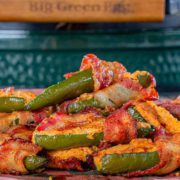The Perfectly Smoked Brisket
From choosing the meat, to seasoning it, setting the bark, and cooking it at the right temperature, you’ll find all the info you need for the perfectly smoked brisket!
Choosing the Meat
Every successful cook begins by selecting the right cut of meat!
When choosing a brisket, consider the overall time commitment.
A large packer brisket combines two different muscles, the pectoralis superficialis, also known as the point, and the pectoralis profundus, known as the flat. These muscles are connected by a seam of fat and are loaded with tough collagen-rich connective tissue that requires at least 12 hours of low and slow cooking to break down the collagen and create a tender, juicy meat.
If you don’t have that kind of time to invest, a great option is to go with the brisket flat, which is usually four to five pounds and takes significantly less time to cook.
You also want to consider the grade of meat.
A prime grade brisket is costlier. But there is usually better fat marbling and a more consistent cook.
Choice grade brisket is less expensive, but the meat may be tougher.
For the ultimate brisket experience, choose a wagyu brisket from a premium meat supplier. No matter which brisket you choose, prepping it properly and seasoning it is a critical step in creating a great result.
Trimming and Seasoning
If you cook a packer brisket, you’ll find a large amount of fat called the fat cap. Much of the fat is hard and won’t render, so this must be trimmed off. Leave at least a quarter-inch layer to keep the meat moist during the cook. Also, make sure to cut off any silver skin.
A simple coating of salt and pepper is most common for smoked brisket. However, there are a myriad of techniques and seasonings you can try. Consider your favorite BBQ rub, steak seasoning, a jar of jalapenos, or even coffee as seasoning options.
Starting the EGG
Load the Big Green Egg with natural lump charcoal and top with either wood chips or wood chunks for the authentic smoke flavor. If using chips, soak in water for 30 minutes prior to use. This slows their burning. Oak, hickory, cherry, apple, or mesquite wood are just a few of the options for flavor, but any hardwood works.
Once the EGG is lit, put the convEGGtor in place for indirect cooking.
Tip: Use a drip pan to catch all the drippings of the brisket and keep your convEGGtor clean. Set the temperature of the EGG between 250ºF and 300ºF by adjusting the top and bottom vents. An EGG Genius is a great option to use to keep the precise temperature for the duration of the cook and to monitor the internal temperature of the meat right on your phone!
Set the Bark
The first phase of cooking a brisket is to set the bark, which is the crispy outer layer. You also flavor the meat with smoke by creating a smoke ring, the reddish band just inside the bark.
Place the brisket directly on the EGG grid fat side up or down based on your personal preference. Some say the fat side up allows rendered fat to flow over the meat and create a juicier brisket.
The flip side of the argument is that putting the fat side down creates more of a barrier between the meat and the fire, creating more tender meat. With the convEGGtor in place and the EGG set at the right temperature, either option produces wonderful results.
Once the brisket is on the grid, smoke the meat until it reaches an internal temperature of 165ºF to 170ºF. During the cooking process, there could be a “stall” in which the internal temperature plateaus around 150ºF to 160ºF. In this case, be patient. The temperature will rise eventually. Once the optimal internal temperature is reached, remove the brisket from the EGG.

Wrapping
The second phase of cooking the brisket is rendering the fat and tenderizing the meat. Wrap the meat in butcher paper or aluminum foil. Make sure the brisket is fully wrapped on all sides so the juices are unable to escape.
If you are using a digital temperature-control system, make sure to put it back into the brisket through the butcher paper. Place the wrapped brisket back on the cooking grid and cook until the internal temperature reaches 200ºF to 205ºF.
This is a crucial step in having the perfect brisket – be sure not to skip it! Allow the brisket to rest for up to two hours to let the juices redistribute, creating a more tender piece of meat. It’s best to keep it wrapped in the butcher paper and placed in an insulated cooler.
Cutting
The most important part of cutting a brisket is the direction of the slices. Before slicing, cut a corner of the brisket to find the direction of the grain. The grain is the alignment of the muscle fibers. If the muscle fibers remain intact, the meat can become strong and chewy. To separate the muscle fibers and ensure a more tender bite, slice against the grain.
Carving a brisket flat is simple. Cut it against the grain about ¼ inch thick slices. A packer brisket is more difficult to carve because the grain of the point is different than that of the flat. Slice the packer brisket in half across its width, which separates the point from the flat. Carve the flat diagonally from one corner to the other. For the point, slice from the cut edge to the back or cut into chunks to be used for burnt ends (also known as meat candy!)
Info from our friends at Big Green Egg.












